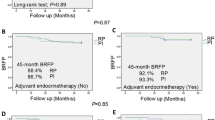Purpose:
To find the factors which influence the acute increment of International Prostate Symptom Score (IPSS) after transperineal permanent interstitial implant (TPI) using 125I seeds.
Patients and Methods:
From April 2004 through September 2006, 104 patients with nonmetastatic prostate cancer underwent TPI without external-beam irradiation. Median patient age was 70 years with a median follow-up of 13.0 months. 73 patients (70%) received neoadjuvant hormone therapy. The increment of IPSS was defined as the difference between pre- and postimplant maximal IPSS. Clinical, treatment, and dosimetric parameters evaluated included age, initial prostate-specific antigen, Gleason Score, neoadjuvant hormone therapy, initial IPSS, post-TPI prostatic volume, number of implanted seeds, prostate V100, V150, D90, urethral Dmax, and urethral D90. In order to further evaluate detailed urethral doses, the base and apical urethra were defined and the dosimetric parameters were calculated.
Results:
The IPSS peaked 3 months after TPI and returned to baseline at 12–15 months. Multivariate analysis demonstrated a statistically significant correlation of post-TPI prostatic volume, number of implanted seeds, and the dosimetric parameters of the base urethra with IPSS increment.
Conclusion:
The base urethra appears to be susceptible to radiation and the increased dose to this region deteriorates IPSS. It remains unclear whether the base urethral dose relates to the incidence of late urinary morbidities.
Ziel:
Ermittlung von Parametern, die nach einer transperinealen permanenten interstitiellen Brachytherapie der Prostata mit 125I eine Zunahme des International Prostate Symptom Score (IPSS) bewirken.
Patienten und Methodik:
Von April 2004 bis September 2006 erhielten 104 Patienten mit nichtmetastasiertem Prostatakarzinom eine alleinige transperineale permanente interstitielle Brachytherapie mit 125I ohne vorherige perkutane Therapie. Das mittlere Patientenalter betrug 70 Jahre, die mediane Beobachtungszeit lag bei 13,0 Monaten. 73 Patienten (70%) erhielten eine neoadjuvante Hormontherapie. Die Erhöhung des IPSS wurde als Differenz zwischen initialem und maximalem IPSS definiert. Analysiert wurden klinische, therapeutische sowie dosimetrische Parameter wie Patientenalter, initialer PSA-Wert (prostataspezifisches Antigen), Gleason-Score, neoadjuvante Hormontherapie, initialer IPSS, Prostatavolumen nach Implantation, Zahl der implantierten 125I-Seeds, die DVH-Parameter V100, V150, D90 für die Prostata sowie Dmax und D90 für die Urethra. Zur detaillierten Untersuchung der Urethrabelastung wurden basale und apikale Urethra definiert, für die ebenfalls DVH-Parameter berechnet wurden.
Ergebnisse:
Der IPSS erreichte 3 Monate nach 125I-Implantation sein Maximum und kehrte nach 12–15 Monaten wieder auf den Ausgangswert zurück. Eine multivariate Analyse ergab, dass das Prostatavolumen nach Implantation, die Anzahl der implantierten 125I-Seeds und die dosimetrischen Parameter der Basisurethra statistisch signifikant mit der Erhöhung des IPSS korrelierten.
Schlussfolgerung:
Die basale Urethra scheint sich als strahlenempfindlich zu erweisen, und die erhöhte Dosis in dieser Region verschlechtert den IPSS. Unklar bleibt, ob die Dosis in der basalen Urethra im Zusammenhang mit dem Auftreten urethraler Spätwirkungen steht.
Similar content being viewed by others
Author information
Authors and Affiliations
Corresponding author
Rights and permissions
About this article
Cite this article
Murakami, N., Itami, J., Okuma, K. et al. Urethral Dose and Increment of International Prostate Symptom Score (IPSS) in Transperineal Permanent Interstitial Implant (TPI) of Prostate Cancer. Strahlenther Onkol 184, 515–519 (2008). https://doi.org/10.1007/s00066-008-1833-3
Received:
Accepted:
Published:
Issue Date:
DOI: https://doi.org/10.1007/s00066-008-1833-3




